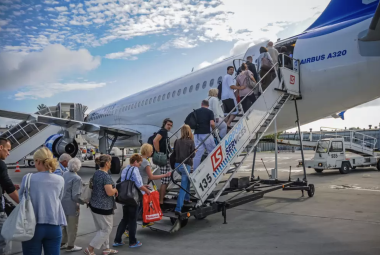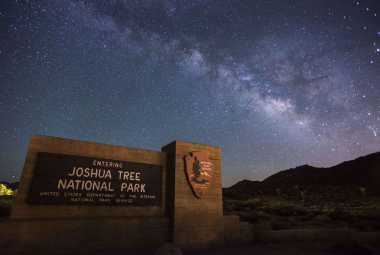Image by wanderwisdom.com
*Vacation Mode is a for-profit site. It contains paid banner advertisements that are generated and managed by a third-party network. This site also includes relevant affiliate links (both in the content and on the sidebar) all of which we do our best to clearly mark as such.
Quick Summary
-
Introduction to Las Vegas Airport
- McCarran International Airport, also known as Las Vegas Airport, is a significant aviation hub in Las Vegas, Nevada, named after U.S. Senator Pat McCarran.
- Established in 1948, it has played a crucial role in the region's air travel growth, undergoing significant expansions and modernizations over the years.
-
Official Name and Historical Significance
- Officially named McCarran International Airport in 1968 in honor of Senator Pat McCarran, who was instrumental in aviation legislation and infrastructure development.
-
Origin and Early Development
- Originally built in 1942 as an airfield for the U.S. Army Air Corps, serving strategic purposes during World War II.
- Transitioned to a commercial aviation facility in the 1950s, marking the beginning of its development into a major airport.
-
Evolution and Modernization
- The airport has seen extensive expansions, including the construction of Terminal 1 in 1963 and Terminal 2 in 1985, alongside technological advancements to enhance passenger experience.
-
Unique Features
- McCarran International Airport is known for its modern architecture, artwork displays, shopping options, and diverse dining experiences, reflecting the vibrant culture of Las Vegas.
-
Busiest Routes and Airlines
- Handles significant traffic on routes to major domestic and international destinations, with major airlines like Southwest, Delta, and British Airways operating.
-
Future Developments
- Plans for further growth include expanding terminal capacity, improving amenities, and implementing sustainable and technological advancements to stay ahead of industry trends.
-
Impact on Las Vegas
- The airport has significantly contributed to Las Vegas's economic growth, job creation, and tourism, while engaging in community outreach and sustainability efforts.
-
Frequently Asked Questions
- Details the airport's history from its initial establishment as a dirt airstrip in 1920, major expansions, significant events, and future plans for development and technology implementation.
Welcome to our comprehensive guide on the history and evolution of Las Vegas Airport. From its humble beginnings to becoming one of the busiest airports in the world, we will explore the official name, original purpose, major expansions, unique features, and future plans of this iconic airport. Join us as we delve into the impact Las Vegas Airport has had on the city's growth and economy, as well as the busiest routes and airlines operating at this bustling transportation hub. Get ready to uncover the fascinating story behind Las Vegas Airport!
What is Las Vegas Airport?
McCarran International Airport, commonly known as Las Vegas Airport, is a major aviation hub located in Las Vegas, Nevada.
- It holds immense historical significance as it was named after U.S. Senator Pat McCarran, a key figure in aviation legislation.
- Since its establishment in 1948, McCarran Airport has played a crucial role in the growth of air travel in the region, catering to millions of passengers annually.
Over the years, the airport has undergone significant development, with the addition of modern terminals, runway expansions, and state-of-the-art amenities, making it a vital gateway to the entertainment capital of the world. McCarran's strategic location and efficient transportation services have further contributed to its prominence in the aviation industry.
What is the Official Name of Las Vegas Airport?
The official name of Las Vegas Airport is McCarran International Airport, named after former Nevada Senator Pat McCarran.
Senator Pat McCarran, who served in the U.S. Senate from 1933 to 1954, played a vital role in shaping aviation policies and infrastructure. His support for aviation development led to the expansion and modernization of the airport, prompting the decision to honor him by renaming it McCarran International Airport in 1968. This renaming was a fitting tribute to a key figure in Nevada's history, recognizing his contributions to the state's growth and the significance of aviation in connecting Las Vegas to the rest of the world.
When Was Las Vegas Airport Built?
Las Vegas Airport, now known as McCarran International Airport, was initially built in 1942 to serve as an airfield for the U.S. Army Air Corps.
Located in Paradise, Nevada, the airfield quickly gained strategic importance during World War II, supporting the training of bomber crews. In 1948, it was named McCarran Field after U.S. Senator Pat McCarran. The airport witnessed significant growth post-war, transitioning into a commercial aviation facility in the 1950s. Its early development was marked by the addition of passenger terminals and infrastructure to accommodate the rising demand for air travel to and from the iconic city of Las Vegas.
What Was the Original Purpose of Las Vegas Airport?
The original purpose of Las Vegas Airport, now McCarran International Airport, was to support military aviation operations during World War II.
The strategic location of the airport played a pivotal role in facilitating the movement of troops, supplies, and aircraft across the western United States. Serving as a training base for bomber crews, Las Vegas Airport became a hub for military operations, aiding in the defense efforts during wartime.
Its significance extended beyond the war era as it transitioned into a vital civilian airport, fostering the growth of commercial aviation in the region. The airport's rich history reflects its evolution from a military airfield to a bustling international gateway.
How Has Las Vegas Airport Evolved Over Time?
Las Vegas Airport, now McCarran International Airport, has undergone significant evolution and modernization since its inception in 1942.
Over the years, McCarran International Airport has transformed into a cutting-edge aviation facility, with key expansions and operational enhancements propelling its growth. The airport's development milestones include the construction of Terminal 1 in 1963 and the subsequent addition of Terminal 2 in 1985, catering to the increasing passenger traffic. Technological advancements, such as automated check-in kiosks and state-of-the-art security systems, have streamlined the travel experience for visitors. The airport's continuous efforts to upgrade its infrastructure and amenities have solidified its reputation as a major aviation hub.
What Were the Major Expansions and Renovations of Las Vegas Airport?
Throughout its history, Las Vegas Airport, now McCarran International Airport, has seen numerous expansions and renovations to accommodate the growing passenger traffic and enhance operational capabilities.
To address the increasing demands of modern air travel, McCarran International Airport has initiated major projects such as terminal upgrades, runway extensions, and facility enhancements. Terminal expansions have been focused on improving passenger flow, enhancing amenities, and incorporating state-of-the-art technologies to streamline processes. The runway extensions aim to accommodate larger aircraft and handle higher volumes of air traffic efficiently. The facility enhancements have centered on upgrading security systems, improving baggage handling systems, and implementing energy-efficient measures to reduce the airport's environmental footprint while ensuring a seamless travel experience for passengers.
What Are the Main Features of Las Vegas Airport?
McCarran International Airport in Las Vegas boasts state-of-the-art terminals, expansive concourses, a diverse range of airlines, and an array of passenger services and amenities.
The airport's terminals are well-equipped with modern facilities, offering a seamless travel experience for passengers. With multiple concourses connecting various gates, passengers can easily navigate through the airport. McCarran International Airport has established partnerships with major airlines, ensuring a wide selection of flight options to various destinations. From check-in to baggage claim, the airport prioritizes passenger comfort and convenience. Travelers can also enjoy a variety of amenities such as shopping outlets, dining options, lounges, and efficient ground transportation services.
What Makes Las Vegas Airport Unique?
What sets McCarran International Airport apart is its unique blend of modern architecture, captivating artwork displays, diverse shopping options, and exquisite dining experiences.
From the moment visitors step foot into this bustling airport, they are greeted by sleek lines and innovative design, creating a sense of space and modernity. The art installations scattered throughout the terminals offer a glimpse into the vibrant culture of Las Vegas, adding a touch of sophistication and artistic flair to the travel experience.
For those looking to indulge in some retail therapy, the airport boasts a wide array of shops, ranging from luxury boutiques to convenient stores, catering to every traveler's needs. As for dining, passengers can embark on a culinary journey, with an impressive selection of restaurants serving up a diverse range of cuisines, from gourmet dining to quick bites on the go.
When Was Las Vegas Airport Built?
Las Vegas Airport, now known as McCarran International Airport, was initially built in 1942 to serve as an airfield for the U.S. Army Air Corps.
What Were the Major Expansions and Renovations of Las Vegas Airport?
Over the years, McCarran International Airport has undergone substantial expansions and renovations to accommodate the growing demands of air travel.
These expansion initiatives have significantly improved the airport's terminal facilities, enhancing passenger comfort and convenience. The addition of new gates, lounges, and retail spaces has transformed the travel experience for visitors. Runway enhancements have increased operational efficiency, allowing for more streamlined take-offs and landings. The overall infrastructure upgrades have modernized the airport's systems, making it more technologically advanced and capable of handling increased air traffic. These developments have positioned McCarran International Airport as a hub for seamless travel experiences.
What Are the Main Features of Las Vegas Airport?
The main features of McCarran International Airport include modern terminals, efficient concourses, a diverse selection of airlines, comprehensive passenger services, and an array of amenities.
What Makes Las Vegas Airport Unique?
McCarran International Airport stands out for its exceptional architectural designs, captivating art installations, diverse shopping opportunities, and culinary delights.
The airport's architecture seamlessly blends modernity with a touch of Vegas flair, featuring sleek lines and innovative structures that create an inviting ambiance for travelers. From stunning sculptures to vibrant murals, the artistic displays throughout the terminals offer passengers a visual feast that reflects the cultural richness of Las Vegas.
Retail options range from high-end luxury brands to local boutiques, ensuring that every traveler can find something to suit their style. The dining establishments at McCarran cater to diverse palates, offering everything from gourmet cuisine to quick bites, making it a culinary destination in its own right.
What Are the Busiest Routes in and out of Las Vegas Airport?
Las Vegas Airport, particularly McCCarran International Airport, handles significant passenger traffic on popular routes to and from major domestic and international destinations.
The busy airport sees a high volume of flights connecting Las Vegas to cities like Los Angeles, New York, Chicago, and Dallas within the United States, as well as international hubs like London, Tokyo, and Mexico City.
With a diverse range of airlines operating at McCarran, such as Southwest, Delta, American, and British Airways, travelers have various options for their journey.
The airport's strategic location and efficient operations make it a crucial hub for travelers heading to famous entertainment and business destinations worldwide.
What Airlines Operate at Las Vegas Airport?
A multitude of airlines operate at McCarran International Airport, connecting Las Vegas to a wide range of domestic and international destinations.
These carriers play a pivotal role in enhancing the airport's operational network by offering a seamless array of flight options. From major global players like Delta and United to regional specialists like Southwest and Allegiant, travelers have a plethora of choices. Through strategic partnerships and diverse route offerings, passengers can easily connect to popular cities across the United States and beyond. The comprehensive destination portfolio ensures that McCarran serves as a vital hub for both leisure and business travelers, fostering connectivity and convenience.
What is the Future of Las Vegas Airport?
The future of McCarran International Airport is poised for further growth and innovation, with ambitious expansion projects and strategic master plans set to shape its development.
These initiatives aim to enhance overall passenger experience by increasing terminal capacity, improving amenities, and implementing sustainable practices. By staying ahead of industry trends such as digital transformation, biometric technology, and efficient security protocols, McCarran Airport is positioning itself as a progressive and technologically advanced aviation hub. The airport's future evolution also includes plans for runway expansions, new taxiways, and smart airport solutions to accommodate the anticipated growth in air traffic and passenger volumes.
What Are the Planned Expansions and Upgrades for Las Vegas Airport?
McCarran International Airport has ambitious plans for future expansions and upgrades, focusing on enhancing technological capabilities, improving facilities, and optimizing passenger experiences.
- These proposed enhancements include the integration of cutting-edge technologies such as biometric security systems to streamline the check-in process and provide a seamless travel experience for passengers.
- Plans are underway to modernize the airport's infrastructure by implementing eco-friendly initiatives like energy-efficient lighting and sustainable building materials.
- Passenger-centric upgrades will also feature new retail and dining options, expanded lounges, and enhanced connectivity for travelers to stay connected throughout their journey.
What Impact Has Las Vegas Airport Had on the City?
McCarran International Airport has significantly influenced the city of Las Vegas through its substantial economic contributions, community engagement initiatives, and commitment to sustainability.
- Its economic significance is evident in the airport's role as a major economic driver for the region, providing a robust source of employment, generating revenue streams for local businesses, and attracting investment opportunities.
- In addition to its economic impact, the airport's community outreach programs have fostered strong relationships with the residents of Las Vegas, promoting education, healthcare, and cultural initiatives.
McCarran International Airport's sustainable practices, such as energy efficiency measures and waste reduction programs, have positioned it as a leading example of environmental stewardship in the aviation industry.
How Has Las Vegas Airport Contributed to the Growth of Las Vegas?
McCarran International Airport's integral role in Las Vegas's growth is evident through its economic stimulus, development projects, and collaborative community engagements that have propelled the city forward.
- The airport's economic impact extends beyond direct revenue generation, as its presence has catalyzed job creation in various industries such as hospitality, transportation, and retail.
- In addition to driving tourism and business opportunities, McCarran Airport has initiated innovative development initiatives, including infrastructure expansions, technological advancements, and sustainability efforts to meet the evolving needs of travelers and residents alike.
Through strategic partnerships with local organizations and government entities, the airport has played a vital role in enhancing Las Vegas's infrastructure, connectivity, and overall quality of life.
What Economic Benefits Does Las Vegas Airport Bring to the City?
McCarran International Airport serves as a vital economic engine for Las Vegas, generating employment opportunities, revenue streams, and promoting tourism through its aviation operations.
The airport's significant role in job creation is evident in the employment opportunities it provides directly and indirectly, such as airline staff, retail outlets, and transportation services. Revenue generation is a key aspect benefiting not only the airport itself through ticket sales and facility rentals but also the surrounding businesses that cater to travelers. The airport plays a crucial role in promoting tourism by serving as a gateway for visitors to access the city's world-renowned entertainment, hospitality, and gaming industries, further contributing to Las Vegas's economic prosperity.
Frequently Asked Questions
What is the history of Las Vegas Airport?
The history of Las Vegas Airport, also known as McCarran International Airport, dates back to 1920 when it was first established as a dirt airstrip named Alamo Airport.
When did Las Vegas Airport become McCarran International Airport?
In 1948, Alamo Airport was renamed to McCarran Field in honor of Senator Pat McCarran, and in 1949, it officially became McCarran International Airport.
What major events have occurred at Las Vegas Airport?
Throughout its history, Las Vegas Airport has been a hub for important events such as the development of commercial air travel, the introduction of jet service, and the hosting of several presidential visits and political events.
How has Las Vegas Airport evolved over time?
Since its establishment, Las Vegas Airport has undergone numerous expansions and renovations to accommodate the growing number of passengers and airlines. In recent years, it has also implemented new technologies and sustainable practices to improve the overall airport experience.
What is the significance of Las Vegas Airport in the city's history?
Las Vegas Airport played a vital role in the growth and development of the city, serving as a major transportation hub for tourists and locals alike. Its success has also contributed to the economic prosperity of Las Vegas as a popular tourist destination.
What plans are in place for the future of Las Vegas Airport?
Las Vegas Airport is continuously expanding and improving to meet the growing demand for air travel. Future plans include the addition of a new terminal and runway, as well as the implementation of advanced technologies to enhance safety and efficiency.


















